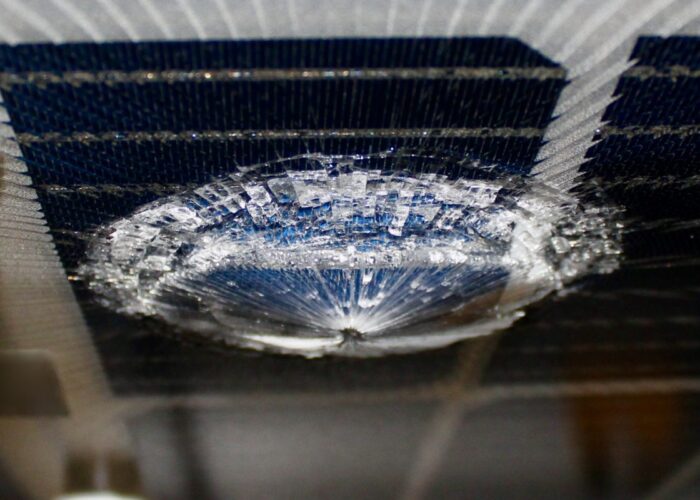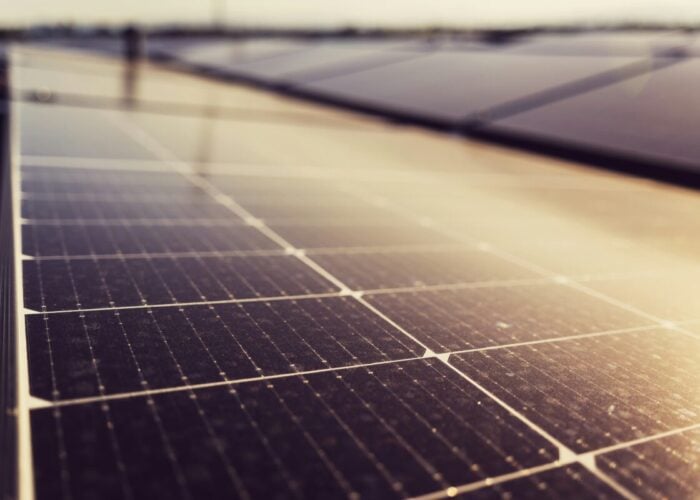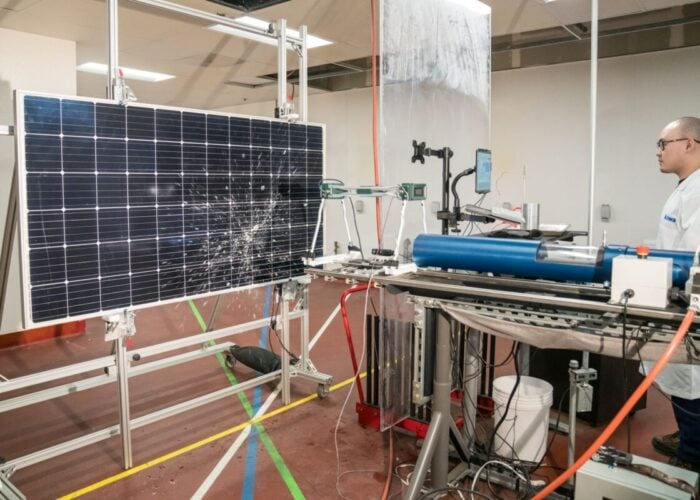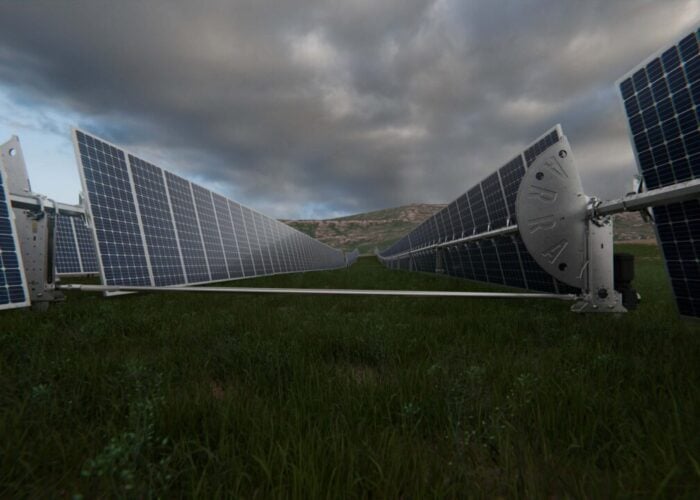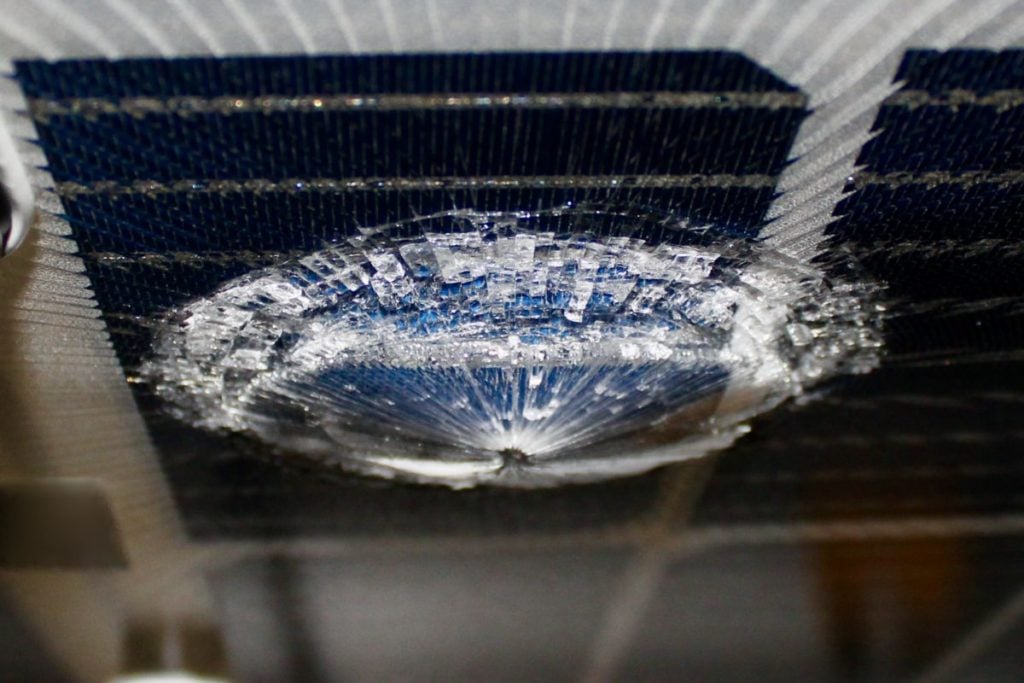
Hailstorms can cause severe damage to solar PV plants. In Texas, 400,000 of a solar plant’s 685,000 modules were damaged in a hailstorm in 2019, causing at least US$70 million in damages. This extreme weather event highlights an essential question to solar PV developers: How can we minimise losses caused by hailstorms?
According to Spanish Solar tracker provider Soltec, hailstorms resulted in construction-related losses exceeding US$1 billion in 2021 in the US.
Unlock unlimited access for 12 whole months of distinctive global analysis
Photovoltaics International is now included.
- Regular insight and analysis of the industry’s biggest developments
- In-depth interviews with the industry’s leading figures
- Unlimited digital access to the PV Tech Power journal catalogue
- Unlimited digital access to the Photovoltaics International journal catalogue
- Access to more than 1,000 technical papers
- Discounts on Solar Media’s portfolio of events, in-person and virtual
Soltec has recently published a whitepaper examining how to stow solar modules to lower losses. In the whitepaper, the company says the high hardness of materials used to form the front side of solar modules is beneficial against damages such as abrasion. However, such materials result in high brittleness, and therefore, modules are highly susceptible to impact-induced damage.
As a result, it is necessary to protect modules against hail.
Fixed-tilt solar modules lack flexibility against hailstorms. On the contrary, solar modules coupled with trackers can better adapt to this weather, although modules can still be seriously damaged without a proper stow strategy.
The Central US is an area prone to hailstorms. Texas, Oklahoma, and Kansas are some of the major states with higher chances of having larger-sized hailstones.
The inside of a hailstorm cloud is constantly moving and changing, making it impossible to forecast when hail becomes too heavy to stay in the cloud, where it will land or the size of the hailstones. In other words, hail strikes are completely random, although a typical hailstorm usually lasts no more than 15 minutes.
How to protect modules?
But there are services available on the market for hail protection.
“Our hail stow system (Hail Algorithm) is equipped with specific hail detection sensors that are used in parallel with weather forecasts. This is certainly a significant advantage compared to manually triggered systems, as it provides an early warning,” Soltec says in the whitepaper.
After receiving an alert, the Hail Algorithm will adjust the hail stow mode based on wind speed. The trackers will return to their tracking position upon detection that the alert has passed.
Soltec says the Hail Algorithm responds quickly to reduce module exposure to hail impacts. Additionally, the motors of the company’s trackers boast a final rotation speed of 20 degrees per minute.
“Given the rapid evolution of hailstorms, it is necessary to have quick activation mechanisms, as that is an advantage when it comes to damage prevention,” says the company.
A hail defence position typically corresponds to the maximum tracking angle opposite to the wind direction. Therefore, the front side of a solar module will be less exposed to the oblique trajectory of hailstones.
The rear side of the module will also be protected as it is not completely vertical.
“(Hail) damage can be catastrophic and result in a major impact, both in terms of replacement of damaged modules, but also of power plant production losses. Therefore, it is important to have an early detection stow system equipped with sensors, as well as to equip trackers with a prompt response mechanism moving them to the best position,” says Soltec.
Nicole Thompson, data scientist of climate insurance provider kWh Analytics, agrees that moving solar modules into a hail stow position is an effective and well-documented mitigation technique. Solar PV plant operators should “proactively stow panels at the first sign of potential severe weather.”
In addition, there are several factors that solar PV plant developers can take into consideration when designing a site to be resilient to hail, including choosing the right type of modules.
“Thicker, tempered glass with a polymer backsheet will fare much better in a hailstorm than a, for example, two-millimetre untempered dual glass module,” she says.
Solar module testing services are available on the market, but the services might not be enough to protect solar PV plants.
Thompson adds: “Having a robust tracker, a conservative yet proactive stow programme, and resilient modules provide the highest level of protection in the face of hail.”
Energy loss due to stowing
Stowing panels requires moving out of the optimal production angle, which could incur revenue loss. To examine this issue, kWh Analytics simulated one year of production for a 200MW single axis-tracker site located in Texas, utilising pvlib python – a community supported tool providing a set of functions and classes for simulating the performance of solar PV systems – and historical watches, warnings and advisories (WWAs) from the National Weather Service.
There were two scenarios in the simulation. First, it proactively moved to a hail-stow position ahead of an impending storm. Second, it retained the optimal production angle during all WWAs.
“What we found is that because skies are generally cloudy ahead of a hail storm, and power generation is lessened significantly. Revenue loss due to a hail-stow position for this simulated site was extremely minimal, around 0.1%,” says Thompson.
She further advises: “If you consider this with the fragility of panels in the face of hail and the quick onset of hailstorms, the picture becomes clear: stow early and stow often.”
PV Tech Power will be running a separate analysis examining the scale of the problem and how the industry is responding to extreme weather in the upcoming edition of PV Tech Power 37, due out in December.



